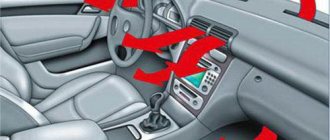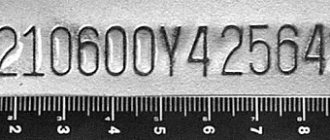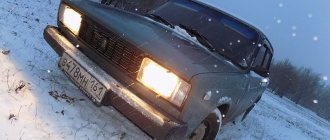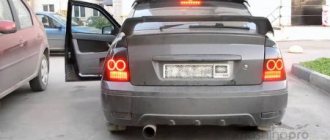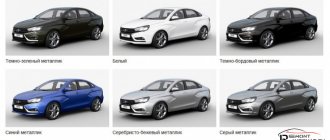05 February 2018 Lada.Online 9 099 0
Assembly of the Lada Vesta began on September 25, 2015 at the LADA Izhevsk plant. It takes 19 hours to assemble one car from scratch. AVTOVAZ periodically demonstrates to its fans individual stages of the production of this car. At the end of 2022, one of the cheb.media editorial staff visited the plant, who spoke in detail about how LADA Vesta is produced.
Stamping
In 2015, the workshop was significantly modernized for its own production under the supervision of Japanese specialists. In 2022, for the production of LADA Vesta SW and LADA Vesta SW Cross, stamping of 79 new and modified body parts was mastered. There is a special control table for each of them. Two years ago, a new XL press line went into operation (four presses with a total force of 5,400 tons) for large stampings (sidewalls, doors, wings, etc.).
VAZ build quality
Well, and most importantly, at the very end of the excursion there was practically a ready-made Vesta body that you could look at and touch - it was bare, without sealant, just body panels and a welded body, probably the body was selected and the best one was put up.
The body itself was covered with cataphoresis primer (otherwise the car would simply quickly begin to rust). However, I found a bunch of shortcomings, all of them a consequence of manual assembly, and not by robots, and the quality and geometry of the stamped parts. Let's start in order - the rear panel on the right, its connection to the body looks like this
Everything fits smoothly and tightly, the corners match. Let's look at what's on the right side:
The surfaces do not match, the corners too, it seems that the rear panel is larger in geometry than the body and does not fit into it by at least a few millimeters, some of the welding points are already almost torn off, and upon impact they will simply tear apart very easily.
In addition to the fact that this deprives the car of safety, all the required soil will not get there in the required quantity, it will not be sealed with sealant and the inside will definitely rust intensively, condensation will accumulate, and dirt will definitely fly in from under the bumper.
And this is not just one such place - there are many of them:
In some places, at the corners, apparently so that it doesn’t bulge at all and at least somehow fits, the panel is bent and simply secured by ordinary welding - there the metal will be lowered and will definitely begin to rust, and cavities will contribute to this in every possible way, besides, this is all impossible cover it with sealant, and during operation it still loses its properties, peeling off somewhere, especially with surfaces like these.
Same situation:
And it would be okay just in this place, let’s look at the fit of the roof panel to the load-bearing element, the fit of the pillars to the load-bearing element of the roof:
The threshold in this exhibition body turned out to be crooked, so they cleaned it up like this; I think you can see the door gaps for yourself.
Moreover, it would be good if these were simply unadjusted gaps, but they are simply impossible to adjust - since then the edges of the “X’s” on the doors and wings will not match, and on the one hand it is more or less normal... And so everywhere I go to look...
Nevertheless, even such not the largest and most advanced production is perceived as some kind of miracle - it is here that quite quickly and literally before your eyes, a car grows from a heap of iron. Well, there is a peculiar aesthetics of production - cables, pieces of iron, strange things, all this is accompanied by corresponding sounds and sensations. And the people who are here instead of robots, manipulate the huge paws of spot welding, making noise, crackling and sparks flying around, isn’t this a paradise for a techie?
And the premises themselves are quite vast and the conveyor is quite long, so you will have to walk a long way. And there’s plenty of time to get tired of the noise, impressions and new information, but more on that in the next part, where I’ll talk about how Vestas are painted and all the other components and electronics are assembled directly onto the body.
I also ask you not to make hasty conclusions or conclusions in general based on this article, let’s leave them for the finale!
Cool article? Share!
Author: Yuri (Er...)
expert on cars and motorcycles in Perm
About me
Welding
This workshop also received a new birth with the arrival of LADA Granta production and additional modernization with the production of LADA Vesta. Parts of future machines travel along a one-kilometer transport line. Real, live welders are assisted by robotic welders - for example, 36 automatic line robots are used to weld the chassis and body.
In order to see what is happening in this workshop without harm to health, special glasses are issued. Very stylish. The welded elements are run through a 3D control and measurement laboratory. Thousand-watt lamps reveal even the smallest defects, which are immediately corrected, if any.
The skeleton of the future car, moving along the conveyor, acquires wings, doors, trunk lid and hood, passes the next control point, and then is sent for painting.
AvtoVAZ conveyor
By the way, almost all the equipment, machines, presses are all imported. As you know, our country, at the moment, is not capable of producing high-quality machines for such an industry, from domestic ones, from what I saw, only tables, carts, all sorts of small things.
On the one hand, of course, this is sad, because before it was all domestic, but on the other hand, at the moment, this is the only way to ensure at least some acceptable quality of parts, however, in my opinion, the point is not so much in them as in attitude towards work, quality control.
So, for example, the kaizen system was taken from Japanese factories, and so it’s not even a system, but a whole philosophy, it lies in the continuous improvement of production processes, development, auxiliary business processes and management, as well as all aspects of life, respectful attitude towards the client - main postulate. It’s very cool to change not just production processes, but the entire philosophy of both the plant itself and the people working at it. I don’t know how successfully this was implemented at this plant, but it’s a cool thing, Toyota was the first to introduce it, and such borrowing is very commendable.
By the way, for those who are interested in this philosophy and how to apply it in life and business, I highly recommend reading Masaaki Imai’s books “Kaizen: the key to Japanese success.” At the very least, it will be useful for general development, and if you work in an enterprise or have your own business, it will be very relevant!
It’s unlikely that the workers at VAZ read them, but the topic is suitable for personal efficiency and the efficiency of business processes. Nevertheless, brief theses and partial pieces from there are visible at the plant - in the form of slogans, posters, and stands.
In general, the conditions and attitude of the employees, of course, changed and clearly for the better - correct communications, open participation of the same employees, it was easy to come up and ask some questions, they were answered, to the extent possible. I was even able to immediately stumble upon the person I needed, but more on that later.
Many little things make up the production culture, for example, labor protection and human health. The next workshop was the welding shop, and at its entrance, right after the warehouses with body parts, there were boxes and tables with glasses to protect the eyes - really well done. Nothing like this happened last time. And glasses were really needed - the corridor with visitors is located in close proximity to the conveyor itself and sparks and scale from welding fly in all directions, for example, onto the fur coat of a glamorous woman standing next to her, but nothing, they were extinguished))
One of the most important operations for maintaining accuracy, and subsequently the rigidity of the body, is the assembly of the car body itself: these are the side panels, the engine shield, the rear panel, the floor and the roof. Almost everything depends on how this is done.
In modern production, such an important operation to eliminate errors and maximize accuracy, and because the parts are very large, this is done by robotic manipulators - at the same time, all these parts are assembled in jigs, grabbed by robots for spot welding, and then scalded at the next post by other robots. This is not the case here, but everything is done the old fashioned way - it is partially assembled, welded in parts using ordinary semi-automatic welding, and gradually the body acquires a cage.
There are many disadvantages to this: there is no precision of robots, it is hard work, there is every chance that the bodies will be different and the geometry will simply go wrong, conventional welding not only destroys the anti-corrosion layer of galvanization, but also lowers the metal - in these places it will rust. But this is most likely cheaper - such robots are very expensive, so this is one of the most critical operations.
However, robots are partially used at some positions, but their use is not very significant, to put it mildly.
By the way, in this part of the assembly it becomes clear, even from the color, that several different metals are used for different parts. You can immediately see that some of the fasteners are welded by simple welding - this is a minus.
There is also defects, there are separate containers for this. In some places there is a lot (and the details have already been checked!).
Next, the body is gradually scalded and overgrown with other parts to the power cell, partly this is done by robots, but most of it is manual labor with the most ordinary tools, and there is a roar here - some of the parts are not very even, they are immediately straightened with hammers, adjusted with sledgehammers and ordinary wrench...
They are adjusted and already welded, so a sledgehammer, a hammer and a mallet are very common tools on this assembly line, most probably only on UAZ or in completely manual production.
Some body panels are rolled; in modern production, sealant is always applied to the rolling by a robot, then rolled by a robot, this happens with doors, for example, and hoods. But not here - here the rolling is done by robots, but the sealant is applied by people and only partially, for the most part it is not done - this potentially threatens rapid corrosion.
The sealant and glue used is this:
Of course, the finished bodies are checked (how?? But more on that a little later), where they find flaws, they are circled with a marker and sent for elimination - grinding, straightening, fitting, etc.
Here the identified deficiencies are eliminated
